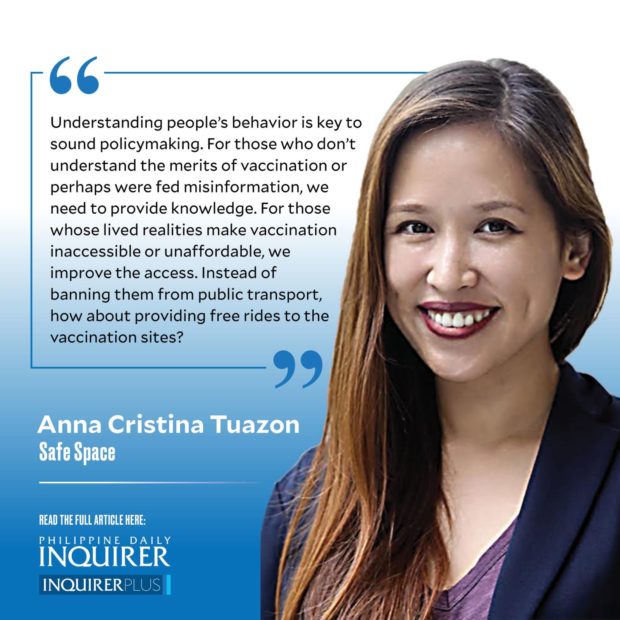No money, no ride
Once again, we have an assumedly well-meaning but flawed rule. The “no vaccination, no ride” policy took effect last Monday, providing yet another obstacle for people who have no choice but to commute in order to earn a living. They might as well have called it the “no money, no ride” policy. Do I wish that everyone get vaccinated as soon as possible? Yes. Will this policy force some people to get vaccinated? Perhaps. Can the rich ignore this policy? For sure. Does this policy discriminate against the poor? Definitely.
This is the problem with bans and restrictions as a strategy. It ends up discriminatory because it only works for people who don’t have the resources to get around it. Discrimination happens when you place barriers that only affect a certain sector. Fines and penalties for this policy target PUV operators and drivers who can hardly earn enough as it is. Punishment-based behavior management always facilitates escape behaviors. As such, ticketing will promote bribery and facilitate abuses by enforcers who take advantage of people desiring escape.
One aspect that our leaders in this pandemic still fail to grasp is that one-size-fits-all policies do not work. Our socioeconomic disparity alone requires a stratified approach. Bans and restrictions imply that you have the knowledge, access, and capability to get vaccinated; you just simply choose not to. This is privileged thinking. Privilege leads to lazy thinking. Because we don’t want to spend time and effort in understanding why people haven’t gotten vaccinated, we’d rather just force them to do so.
Some people in government resort to the “pasaway” explanation to justify mandates and restrictions. But understanding people as “pasaway” is also lazy thinking. If we explain the cause of behavior as due to being “pasaway,” it simply means that we refuse to understand the true cause. As someone who teaches behavior management, I train people to remove words like “pasaway” and “matigas ang ulo” from their vocabulary simply because it stops them from finding effective solutions to people’s problems. When someone is not engaging in health-promoting behaviors, we have to consider that they perceive the behavior as something not worth doing. More importantly, it is their lived reality and context that determines whether something is worth doing. No behavior is without cost. It may be in the form of time and money; sometimes the cost is a more valued behavior like earning money or providing for the family. To effectively promote healthy behavior, we must convince people that these behaviors are worth doing. We need to highlight the benefits of vaccination, such as minimized symptoms and complications, and tie it into what is important for most people: that it will prevent them from having to spend more on treatment costs in the future, saving them time and money in the long run. If they are the breadwinner of the family, all the more they can’t afford to get sick.
At the same time, we should remove or minimize the cost of getting vaccinated. Just because vaccination itself is free does not mean it has no cost. An individual will have to take time off work, something that they cannot afford. It also costs money to travel to the vaccination sites. We should prioritize shortening wait times so that people don’t have to apportion a whole day in this endeavor. If possible, we can provide compensation for the time spent away from income-earning activities. We need to make vaccination so convenient that it’ll take more effort just to avoid it.
Understanding people’s behavior is key to sound policymaking. For those who don’t understand the merits of vaccination or perhaps were fed misinformation, we need to provide knowledge. For those whose lived realities make vaccination inaccessible or unaffordable, we improve the access. Instead of banning them from public transport, how about providing free rides to the vaccination sites?
Placing barriers to daily living does not solve problems, it only adds to them. Instead, how about we remove barriers to getting vaccinated? Drive-through vaccination sites are a good idea—for the middle and upper class. Let’s diversify our strategy and set up mobile vaccination sites that can reach far-flung barangays. Instead of mega sites, which promote crowding and require traveling long distances, we can decentralize vaccinations and bring them to the barangay level. Let’s make lives easier, not harder.

















